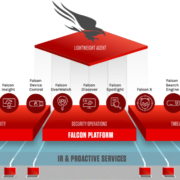The world has changed, and protecting one’s network has been thrusted to the top of every CEO's checklist and the CFO is there to make it happen smoothly as well.
Just how to protect the most critical computer networks is still a work in progress; many firms still haven’t got a clue.
Just recently, oil pipeline operator Colonial Pipeline revealed that it had opted to pay hackers a $4.4 million ransom to regain control of its infrastructure.
Another headline rattler, major meat company JBS learned they, too, had been hacked.
The ultimate cost of all this hacking?
Cybersecurity Ventures currently pegs the annual figure at around $6 trillion, though further estimates that the ransomware "business" will be worth $10.5 trillion by 2025.
Threat actors are well resourced and becoming more sophisticated as we speak.
Crazily enough, ransomware-as-a-service sites are making it simpler for even novice e-criminals to run successful and lucrative campaigns, which is contributing to the proliferation of ransomware activity.
This is highly illegal yet actors from abroad feel almost immune wielding their power from offshore authoritarian strongholds where dictators usually chuckle on the news that western companies have been hacked again.
The 2020 CrowdStrike Global Security Attitude Survey revealed that more than half of organizations surveyed worldwide had suffered a ransomware attack within the previous 12 months.
A scary fact is that many of these ransomware attacks, failures and successes, are not publicly reported because companies don’t want the negative publicity and the accompanying stock sell-off with it.
Some hacks are just too big to hide under the carpet.
At the same time, organizations need to transform their businesses in order to keep up with evolving business needs such as work from anywhere and moving their critical applications and workloads to the cloud.
Naturally, this is the perfect time for hackers, new and old, to pounce on the transitory nature of deploying networks into a work-from-home set-up.
CrowdStrike’s Falcon platform is at the epicenter of restoring trust to the security apparatus of companies worldwide.
The integration of threat intelligence and threat hunting into the Falcon platform provides deep insight into the adversaries and how they operate.
Extensive capabilities of the Falcon platform significantly set CrowdStrike apart from both legacy and next-gen vendors.
This includes their acquisition of Preempt and Humio, which could not have been timelier as companies are discovering new ways to shore up protection of their active directories, stop lateral movement and have even greater real-time visibility and search into their endpoints, identities, applications, network edge and cloud from a single data layer.
CRWD was also recognized as the best cloud computing security solution and best managed security service at the 2021 SC Awards where Shawn Henry, president of services and chief security officer, received a Security Executive of the Year award as well.
This growth company has the accelerating metrics to back up its hubris.
In the first quarter, they reached a new milestone as subscription customers surpassed the 10,000 mark.
They added 1,524 net new subscription customers including the customers CRWD acquired from Humio. On an organic basis, the net new subscription customers added in the quarter grew 69% year over year. In total, they now service 11,420 subscription customers worldwide.
To sum up the positivity, the outperformance is attributed to CRWD’s Falcon platform's ability to fully utilize the power of the cloud and AI to stop breaches and provide community immunity.
Also helpful, is the ability to easily and rapidly deploy lightweight agent at scale across both endpoints and workloads without requiring a reboot, while other next-gen vendors fail to scale and require reboots.
The platform is easy to use and easy to manage all from a single user interface; and their ability to leverage the power of the cloud to collect data once and solve many real-world business problems that deliver better outcomes and immediate ROI for customers.
It is entirely possible that with the rate of ransomware accelerating, CRWD will be able to grow the service base from over 11,000 now to 100,000 in less than 2.5 years.
They should be able to achieve this while accelerating their subscription gross-margin target to 85% which would represent an acceleration of the current gross rate margin of 77%.
This company is growing faster and becoming more profitable, what’s there not to like?
In light of the strength I just mentioned, a pullback to $230 would be a great entry point to ride to over $400.
If the firm can at least deliver 70,000 customers in the next few years, the stock is easily at least $400 which would make it around a $100 billion company.
That is entirely doable for CRWD.




